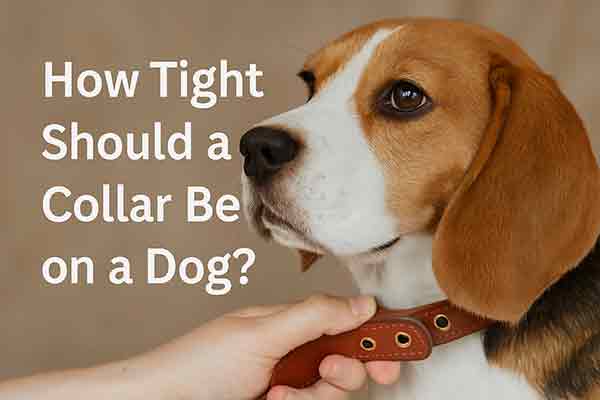How Tight Should a Collar Be on a Dog? | Fit, Safety & Tips
Table of Contents
- Introduction
- Why Collar Fit Matters
- The Two-Finger Rule Explained
- How to Measure Your Dog’s Neck
- Signs Your Dog’s Collar Is Too Tight
- Signs Your Dog’s Collar Is Too Loose
- Choosing the Right Type of Collar
- How Often to Check Collar Fit
- Collar Fit for Puppies
- FAQ
- Conclusion
Introduction
A dog collar is more than just an accessory—it’s a tool for identification, control, and comfort. But how tight should a collar be on a dog? Too tight, and it can cause discomfort or injury; too loose, and your dog might slip out. This guide covers everything you need to know about achieving the perfect fit to keep your dog safe and comfortable.
Why Collar Fit Matters
The right collar fit ensures:
- Safety: Prevents choking, rubbing, and skin irritation.
- Control: Ensures the collar doesn’t slip off during walks or play.
- Comfort: A properly fitted collar won’t cause your dog stress or physical harm.
- Proper ID display: Tags should hang securely and be easily visible.
The Two-Finger Rule Explained
The golden rule for collar tightness is the two-finger rule:
- You should be able to comfortably slide two fingers between the collar and your dog’s neck.
- If it’s too difficult to insert two fingers, the collar is too tight.
- If you can fit more than two fingers easily, the collar may be too loose.
This rule applies to most dogs, but you should also consider your dog’s size, breed, and coat type.
How to Measure Your Dog’s Neck
To get an accurate collar size:
- Use a soft measuring tape around the base of your dog’s neck, where the collar naturally rests.
- Add 1 inch for small dogs, 2 inches for medium dogs, and 3 inches for large dogs.
- Match your measurement to the sizing guide of the collar brand you choose.
Always adjust the collar to the correct tightness after purchase.
Signs Your Dog’s Collar Is Too Tight
Here are some warning signs that your dog’s collar is too tight:
- Chafing or hair loss around the neck
- Redness or sores under the collar
- Coughing, wheezing, or gagging
- Frequent scratching at the collar area
- Visible indentations in the fur or skin
Signs Your Dog’s Collar Is Too Loose
Conversely, a collar that’s too loose can also be dangerous. Signs include:
- Collar slips over your dog’s head easily
- Hanging unevenly or dangling down the chest
- Tags clinking loudly due to movement
- Difficulty controlling your dog on walks
Choosing the Right Type of Collar
Not all collars are created equal. Here are popular options and how they relate to fit:
- Flat collars: Best for everyday use; easy to size using the two-finger rule.
- Martingale collars: Ideal for dogs that slip out of regular collars; should tighten slightly under pressure but not choke.
- Harnesses: An alternative to collars for walking; still requires a properly fitted collar for ID tags.
- Head collars: Useful for training but must be fitted precisely to avoid injury.
How Often to Check Collar Fit
Dogs grow, gain/lose weight, and experience seasonal coat changes, so it’s important to check collar fit:
- Every few weeks for adult dogs
- Weekly for puppies
- After grooming or seasonal coat changes
- Following weight gain or loss
Collar Fit for Puppies
Puppies grow quickly and often outgrow collars in a matter of weeks. Keep these tips in mind:
- Use an adjustable collar with room to grow
- Check the fit weekly
- Monitor for chafing or shifting fit due to growth spurts
- Start leash training early with a properly fitted collar or harness
FAQ
How do I know if my dog’s collar is causing discomfort?
Watch for signs like constant scratching, red skin, hair loss, or resistance to having the collar put on. These may indicate poor fit or sensitivity.
Is a loose collar better than a tight one?
No. A loose collar may slip off, while a tight one can cause harm. Aim for a snug fit with the two-finger test.
Should my dog wear a collar all the time?
While it’s fine for ID purposes, consider removing the collar during sleep or crate time to avoid potential choking risks.
Can collars damage a dog’s trachea?
Yes, especially if the collar is too tight or the dog pulls hard. A harness may be a safer alternative for walking, particularly for small breeds.
How often should I replace my dog’s collar?
Inspect collars regularly. Replace if you notice fraying, stretching, rusted buckles, or if your dog outgrows it.
Conclusion
Getting your dog’s collar fit right isn’t just about looks—it’s about safety, comfort, and control. Follow the two-finger rule, choose a collar type suited to your dog’s lifestyle, and check the fit regularly. A well-fitted collar helps keep your pup safe while ensuring they feel comfortable and confident every day.
For more dog gear tips, safety advice, and pet parenting know-how, be sure to explore the rest of our blog.







